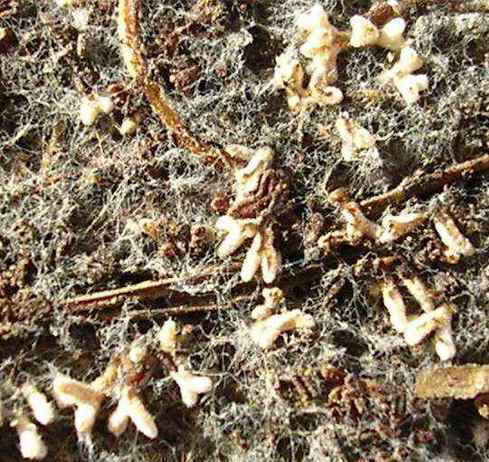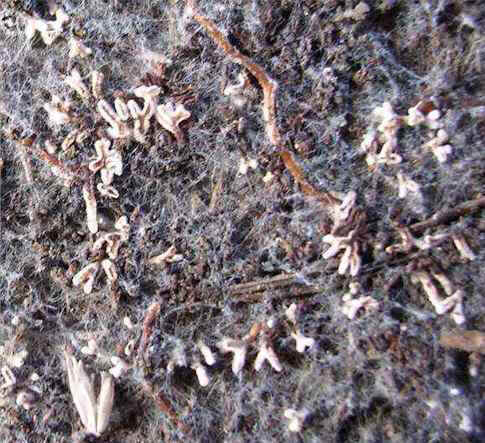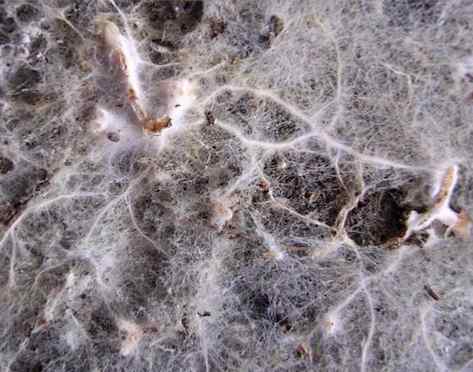..
FOCUS TOPIC - MYCORRHIZAS The term MYCORRHIZA literally means "Fungus-root". It indicates a very close association between the mass of fine roots, about 1 mm diameter, and fungi that grow in or on those roots, helping the plants to obtain mineral nutrients from the soil. As explained in Chapter XX, there are several different types of mycorrhiza. The most common type is termed an arbuscular mycorrhiza and it is found in about 80% of all land plants. In this type of mycorrhiza, fungal hyphae penetrate the root system from one of more "entry points" (see Fig. 1) and then grow between the root cells before penetrating individual root cells to produce highly branched arbuscules (tree-like branching systems). These are shown in Fig. 2 (below). Often - but not always - the arbuscular mycorrhizal fungi also produce large, swollen vesicles, which are thought to contain nutrient reserves. This type of association between plant roots and arbuscular mycorrhizal fungi (AM fungi) seems to have originated in the Devonian period, more than 420 million years ago, because fossils from the Rhynie Chert deposits in Scotland show good evidence that AM fungi and their spores were associated with roots of the earliest land plants and have remained little-changed to the present day. Go to any piece of grass turf, or to clover roots, onion roots, daffodil roots, dandelion roots or the roots of thousands of other plants, and you will see that the roots are full of AM fungi (although you need to stain the roots to see these fungi). And yet, none of these AM fungi can be cultured in laboratory media. They are OBLIGATE symbionts, always dependent on their host plants.
Fig 1. A clover root stained to reveal the arbuscules and vesicles within the root tissues. [© Jim Deacon] Arbuscular mycorrhizas are only one of several types of mycorrhiza. Another common type of mycorrhiza is found associated with the roots of trees such as pines, spruce, oak, beech, chestnut, larch, etc. These are the trees of relatively northern or southern regions of the world, including the temperate, sub-boreal, boreal and sub-alpine forests of the Northern Hemisphere. But the fungi that form mycorrhizas with these trees are members of the Ascomycota and Basidiomycota - the "Higher fungi" that produce produce muchrooms and toadstools. The mycorrhizas of these fungi consist of a compact fungal sheath that encases the fine roots, so that any mineral nutrients taken up by the plants must first pass through this substantial sheath. Fungal hyphae that radiate out from the sheath are responsible for absorbing mineral nutrients from the soil (Fig. 2). There are several other types of mycorrhiza, including the mycorrhizas of heathland plants, and the mycorrhizas of orchids (see Chapter 13). But the important point is that mycorrhizal associations are the norm rather than the exception - mycorrhizas are found on probably more than 90% of all land plants..
Fig 2. Mycorrhizas of the Fly Agaric toadstool (Amanita muscaria) [© Jim Deacon] Why do plants have mycorrhizas? The answer to this question lies in the fact that plant roots need to absorb mineral nutrients from soil, and some of these mineral nutrients such as phosphates are rapidly immobilised in soil. They combine with calcium or magnesium ions, forming insoluble calcium or magnesium phosphates. Alternatively, the phosphates can complex with organic matter, forming insoluble organic phosphates. In most soils, therefore, phosphates are the critical limiting nutrients for plant growth, and plant roots have to go in search of phosphate sources. At this point it is instructive to look at a plant root system (Fig. 3). This image shows the root system of a 3-year-old pine seedling grown in a 15 cm square plant pot. Several fine absorbing roots can be seen - each about 1-2 mm diameter. But the vast majority of the growth that we see is the growth of fungal hyphae, which permeate the soil right through to the centre of the pot. These hyphae are of mycorrhizal fungi, growing from the roots into the soil and thoroughly exploring the soil for mineral nutrients.
Fig 3. A 15 cm square plant pot with a 3-year-old pine tree. Note the fine roots (each about 1-2 mm diameter), but most of the growth we see is of mycorrhizal fungal hyphae that grow from the roots, thoroughly permeate the soil and absorb mineral nutrients. [© Jim Deacon] The key point is that the fungal hyphae provide the massive surface area for uptake of mineral nutrients. These hyphae are about 10 micrometres diameter, whereas the fine absorbing roots are about 1 millimetre diameter (100 times wider). So, the surface area for absorption of mineral nutrients is hugely greater if the plant supports the fungal network with plant sugars and gains at least some benefit from the mineral nutrients absorbed by this fungal system. It is a costly process for the plant. Perhaps as much as 30% of the sugars produce by the plant through photosynthesis is used to maintain the mycorrhizal fungi (see References). Figs 4, 5 and 6 (below) serve to reinforce these points. They show some of the stumpy, short mycorrhizal root tips that are growing against the walls of plant pots. Most of these root tips are bifurcated and covered with a dense fungal sheath. Fungal hyphae radiate from these mycorrhizal short roots, providing intimate contact with the soil for mineral nutrient uptake.
Fig 4. Mycorrhizal short roots of pine seedlings [© Jim Deacon]
Fig 5. Mycorrhizal short roots of pine seedlings [© Jim Deacon]
Fig 6. Mycorrhizal short roots of pine seedlings forming connections with one another through mycelial cords which, presumably, facilitate transport of sugars and mineral nutrients (this being a common role of mycelial cord systems in general). [© Jim Deacon] |





